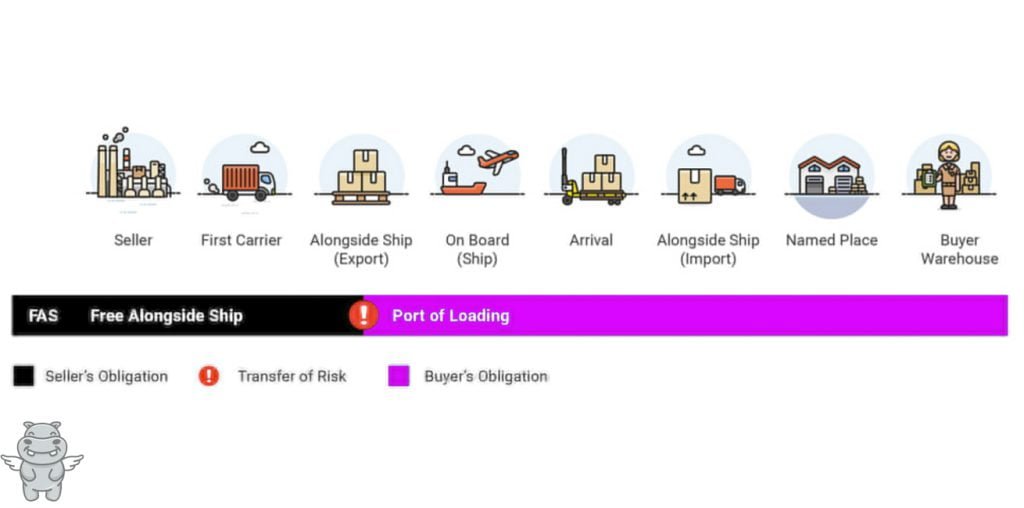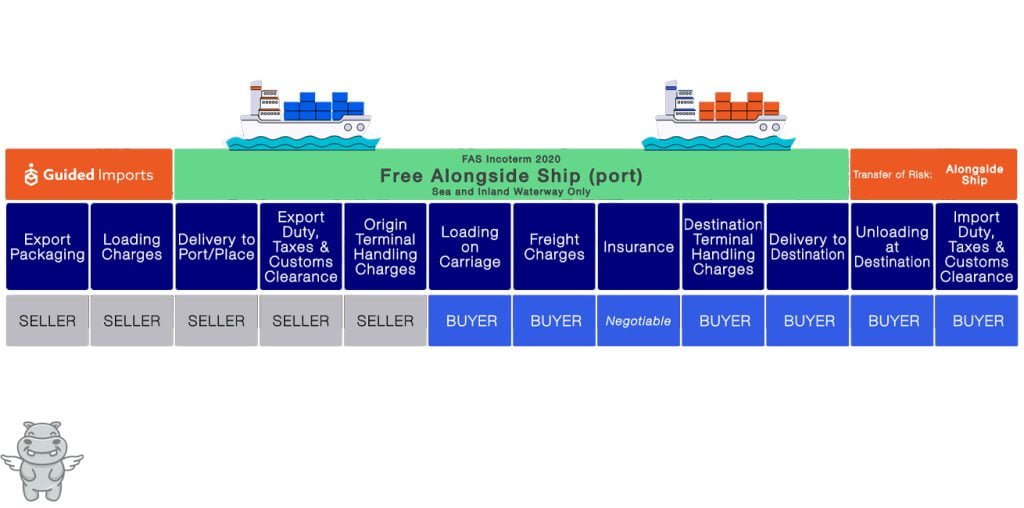What does FAS (Free Alongside Ship) Incoterms mean?
In FAS, the seller clears the goods for export and delivers them at the port of origin next to the ship chosen by the buyer. This means that the seller is in charge of all costs and risks related to the goods until they are delivered. This term is only used for ports on the ocean or on water transport. FCA is a better term to use if the goods are given to the carrier at a container terminal. Under FAS, the seller must deliver the goods right next to the ship at the port dock. Until the goods are at the dock, the seller is responsible for all costs and risks. From now on, the buyer is responsible for the costs and risks of shipping, and he or she takes on the risks.
Usually, this particular hipofly.com/incoterms-guide/">Incoterms rule is used with bulk cargo. This Incoterms rule would make things hard for containerized cargo, which is usually brought to a yard or terminal before being loaded (rather than straight to the ship). In these situations, you might want to use the FCA Incoterms rule instead.
quote is-style-default has-black-color has-pale-cyan-blue-background-color has-text-color has-background is-layout-flow wp-block-quote-is-layout-flow" style="font-style:normal;font-weight:500">This Incoterms rule is often used when the seller has direct access to the vessel and the goods are shipped in bulk. The FCA Incoterms rule is usually used when shipping containers are brought to a terminal.
HipoFly Team
FAS (Free Alongside Ship) works with which shipping methods?
The FAS Incoterm, which stands for “Free Alongside Ship,” is only used for ocean freight shipping.
FAS (Free Alongside Ship) includes insurrace or not?
FAS does not require insurance. But it is common for both the buyer and the seller to buy insurance to cover the parts of the journey that they are responsible for.
As a buyer or seller using the FAS Incoterm, you can also choose to get cargo insurance for the whole shipping process, from beginning to end. No matter what you decide, make sure that your sales contract includes terms for insurance.
What are the advantages of FAS (Free Alongside Ship)?
- The only thing the seller has to do is get the goods to the buyer’s ship.
- It reduces the risk for the buyer because the buyer has control of the goods as soon as they are on the ship.
- It reduces the seller’s risk because the buyer is responsible for loading, so any damage that might happen is not the seller’s fault.
- It makes it less likely that there will be problems because the seller has to help the buyer with any paperwork or documents. This makes the process go smoothly.
What are the disadvantages and risks of using FAS (Free Alongside Ship) terms?
- It can be risky for the seller because the ship might not arrive on time. The seller might bring the goods to the dock or port, only to find that the ship is not there. This makes it more likely that the goods will be lost or damaged before the ship gets to where it needs to be.
- If there is no agreement for the seller to get the goods transported, it is the seller’s responsibility to help the buyer get the documents needed for the goods to be moved. This could make the selling party have more work to do and more trouble.
Who pays for freight when use FAS (Free Alongside Ship)?
Under the FCA Incoterm, which stands for “Free Carrier,” the buyer pays for all freight costs.
When you should use FAS (Free Alongside Ship)?
A buyer should only think about FCA if most of the following conditions are met:
- The cargo they are shipping is in containers.
- They already know how logistics work and what requirements are needed in the seller’s country, or they use a shipping service.
- Their seller likes FCA just as much as FAS or FOB.
- The goods are being sent straight to the export terminal, not to the warehouse of the shipping service provider.
FCA is a good choice for an Incoterm if the four conditions listed above can be met.
FCA agreements for China imports: are they a smart option?
fall into one of the above categories. China is unique because its factories can export so much and do it so efficiently. After all, they mostly use one Incoterm, hipofly.com/fob/">FOB. So, unless there is a good reason why FOB is not best for your shipment, it is best to stick with what works and not slow down or confuse things by trying other terms.
If you are an importer and want to try FCA for your next shipment from China, this is what we suggest. First, find out if your factory is okay with quoting FCA. Second, get in touch with your China freight forwarder or a China 3rd party logistics company to get help comparing FCA and FOB.
And no matter which incoterm you choose in the end, China freight insurance is always a good idea because it’s a small cost to avoid a huge loss or a disruption in the supply chain.

FAS (Free Alongside Ship) incoterm responsibilities
Let’s look at what the buyer and the seller have to do under an FCA agreement.
Seller’s responsibilities:
Export Packaging
The cargo must be packed so that it can be shipped. Some countries have unique requirements for how products must be exported. This can be done with certain markings or types of packaging. The person in charge of this must make sure that the packaging follows the rules for export.
Costs for loading
As the cargo leaves the seller’s location, these are any costs related to loading the cargo onto the first carrier that will take the goods to the export location.
Transporting to a port or place
Once the cargo is loaded onto the truck, these are the costs of getting the goods from where the seller is to the port or place where the goods will be exported. Most of the time, the port or place is an hipofly.com/top-airports-in-china/">airport, seaport, or railport.
Export Duty, Taxes, and Clearing Customs
The costs and responsibilities of exporting the cargo legally from the country of origin. This could include customs checks, pre-shipment checks, or any other special permissions needed to send the cargo overseas.

Buyer’s responsibilities
Charges at the Origin Terminal
Any costs or requirements related to the shipping terminal, which is where the cargo is loaded onto the ship for the main part of the shipping process.
Loading on the Carriage
The shipping line needs to charge a loading fee before the cargo can be put on the carriage.
Transportation Fees
This is the freight charge from the port of origin to the port of destination.
Insurance
Even though insurance is not required, it is up to the buyer to decide if they want to get a policy.
Costs at Destination Terminals
Once the cargo has arrived at the port of destination, any terminal charges related to unloading, moving, and storing the load while the formal import process is going on will be added.
Delivery at Destination
Getting the cargo from the port of destination to the place where the buyer wants it delivered
Unloading at the end point
Any costs that come with unloading the cargo at the place the buyer wants it sent.
Import Duty, Taxes, and Clearing Customs
The buyer is responsible for all the costs and work that come with bringing the goods into the country. If there are any inspections, duties, taxes, or other requests from customs officials, they must be met by the buyer or paid for by the buyer.
Conclusion
The Free alongside (FAS) rule only applies to goods that are shipped by sea or inland waterway. It is often used in trade between countries.
As a contract, FAS specifies the port of delivery, the expected time of delivery, payment plans, and the party responsible for risks and losses, as well as when the risks shift to the other party.
When using FAS, the buyer and seller must also agree on who will pay for shipping costs and insurance.
So, if you still have questions about FAS, you can contact the HipoFly team and ask us.
FAQs
What is the FAS shipping?
The FAS shipping is an international freight forwarding service that helps to move goods from one country to another. It is a common practice that has been used for decades and it still continues today.
What is the difference between FAS and FOB shipping?
FAS shipping is often used by companies that need a quick turnaround time on their shipments. For example, if you are sending a package from New York City to Los Angeles, you would use this type of shipping because it allows you to avoid high freight costs.
What are the advantages of FAS shipping?
FAS shipping has been on the rise since the last few years because of its benefits like reduced carbon footprint, cost-effectiveness and faster delivery times.
The disadvantages of FAS shipping are limited in scope – it doesn’t work for heavy items or oversized boxes.


